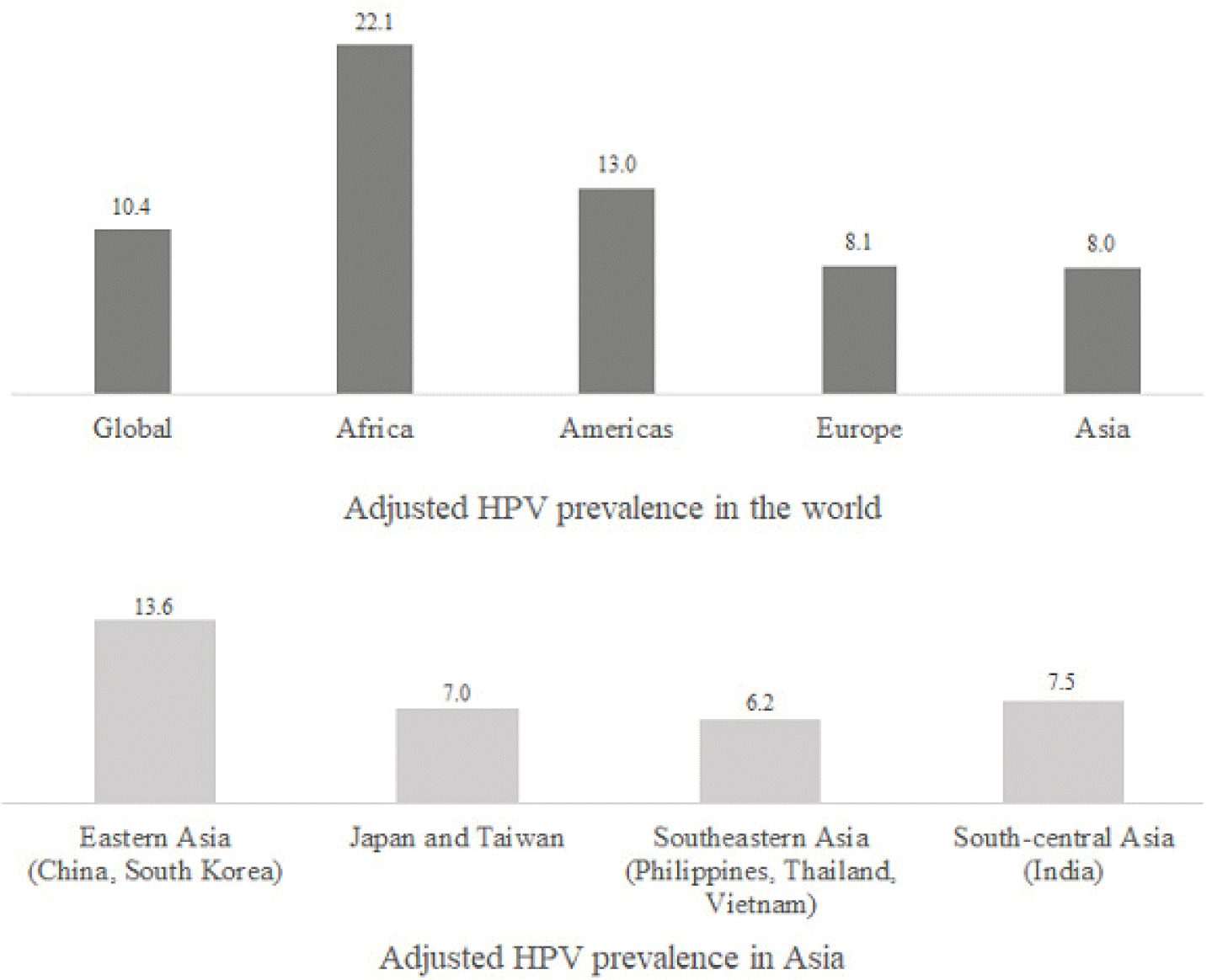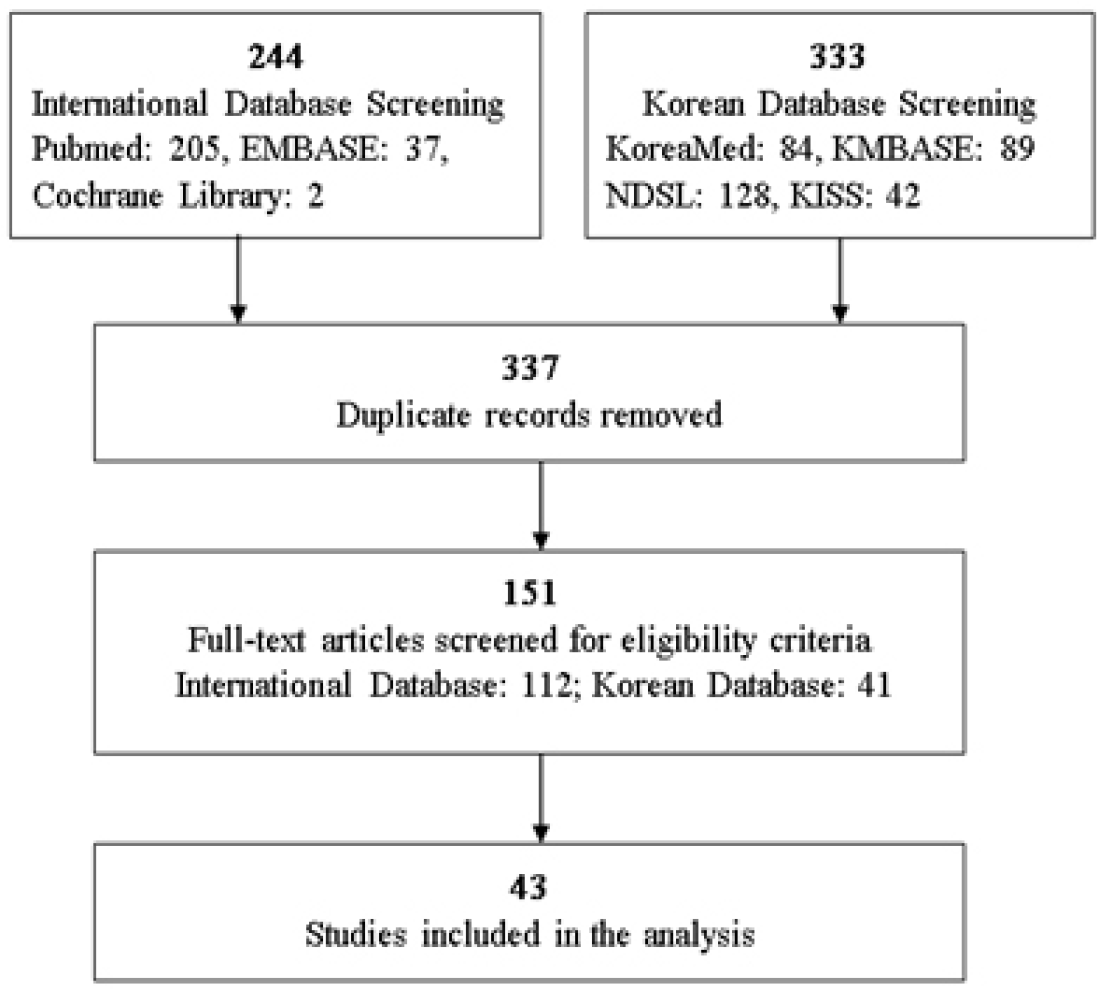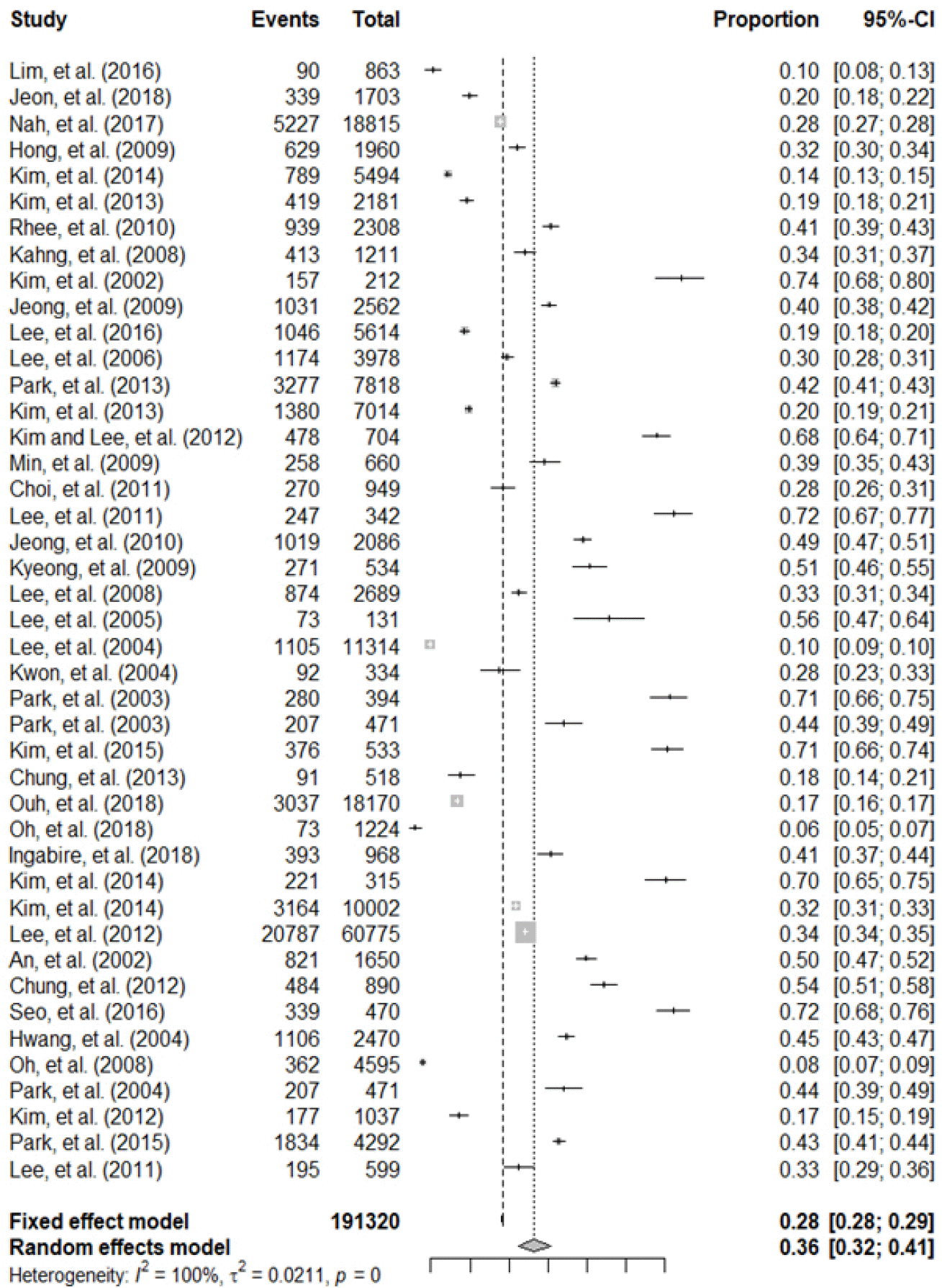INTRODUCTION
In 2018, there were an estimated 570,000 new cases of cervical cancer, with 311,000 deaths worldwide, making cervical cancer the fourth most common form of cancer among women (1). In Korea, 3,582 cases of cervical cancer including 967 deaths were reported in 2015, making it the third most common form of cancer among women aged 15-34 (2, 3). Between 2004 and 2015, the prevalence of cervical cancer in Korean women declined; however, the number of patients diagnosed with carcinoma in situ, cervical intraepithelial neoplasia 1, 2, not designated as cervical cancer, increased 2-fold during the same period (4). Additionally, the overall prevalence of HPV infection in Korean women was 34.2%, with 49.9% of women aged 18–29 years infected (5).
It is known that the major cause of cervical cancer is human papillomavirus (HPV) infection acquired through sexual contact. In most cases (60-80%), there were no specific symptoms and over 70% of HPV infections are cleared within 1 to 2 years (6). Only 20–40% of patients show persistent infections, usually by HR-HPV. Persistent infection by HR-HPVs is the greatest risk factor for developing cervical cancer (~5%), largely because of the complementary function of the E6 and E7 oncoproteins in infected cells (7).
HPV genotype distribution varies according to geographic region and race (8). More than 190 HPV genotypes have been identified and classified into a high-risk group (18 genotypes) and a low-risk group (12 genotypes) depending on the risk of disease progression (9). In particular, as the HPV-16 and HPV-18 are known to take cause 70% of cases of cervical cancer (10), the 2-valent (including HPV-16/18; Cervarix; GlaxoSmithKline), 4-valent (including HPV-6/11/16/18; Gardasil4; Merck & CO), and 9-valent (including HPV-6/11/16/18/31/33/45/52/58, Gardasil9, Merck & Co) vaccines have been commercialized and released on the market to prevent cervical cancer-related genotypes (HPV-16 and HPV-18). Since 2016, 2-valent and 4-valent vaccines have been included in the KCDC's National Immunization Program for girls aged 11-12.
This study aimed to review the characteristic that the HPV prevalence and type-specific distribution of HPV infection based on studies of domestic and overseas, and presented overall HPV prevalence in Korea according to the results of Meta-analysis obtained as part of an internal research project at KNIH (Korea National Institute of Health).
Go to : 
BODY
Worldwide HPV Prevalence and Type Distribution
In a systematic literature review and meta-analysis to assess women with normal cytology, this study found the global HPV prevalence to be 10.4% and the continental HPV prevalence in Africa, America, Europe, and Asia to be 22.1%, 13.0%, 8.1%, and 8.0%, respectively. Among Asian countries, the prevalence of HPV in Korea and China was found to be 13.6%, which was significantly higher than the figures obtained for other Asian countries including Japan, Taiwan, and India (Fig. 1).
In addition to HPV prevalence in the major regions of the world, the infection status among different ages showed that HPV prevalence tended to decrease with age in Asian regions, while it generally tended to decrease with age before rising again after 45 years of age in other regions, which could be explained by a deviation due to the population-specific period and the cohort effect of the study group, or perhaps by the different sexual attitudes in each country. Worldwide, HPV-16, HPV-18, HPV-31, HPV-58, and HPV-52 accounted for about 50% of all HPV infections, with HPV-16 and HPV-18 in particular accounting for about 32% of all infections. Although HPV-16 and HPV-18 generally rank first and second in prevalence, the rate of HPV-52 was the highest in Japan, Taiwan, and East Africa. The results of an analysis of East Asia (including Korea) showed HPV-16, followed by HPV-18, HPV-58, HPV-52, and HPV-70, to be the most prevalent, while HPV-31 and HPV-45 were the most prevalent in other continents. The results also showed a singular point HPV-70, which belongs to the low-risk group, in fifth place (11).
HPV Prevalence and HPV genotype Distribution in Korea
The Report on Human Papillomavirus and Related Diseases published by the International Agency for Research on Cancer (IARC) in 2019 presented the findings on HPV prevalence and genotype distribution in Korea. Based on several meta-analysis, HPV prevalence was found to be about 30%, although the figure differed in each study, while the results of an analysis of HPV genotype by disease grade showed that HPV-16 and HPV-18 had a prevalence of 6.3% in normal cytology, 33.2% in low-grade cervical lesions (LSIL/CIN-1), 46.7% in high-grade cervical lesions (HSIL/CIN-2,3/CIS), and 68.0% in cervical cancer (12).
In the meta-analysis of global HPV prevalence distribution and genotype distribution (in women with normal cytology), the HPV genotype distribution in East Asia was reported to be HPV-16, HPV-18, HPV-58, HPV-52, and HPV-70 (7), in descending order of frequency, while in the Report on Human Papillomavirus and Related Diseases, the genotype distribution was reported to be HPV-16, HPV-58, HPV-70, HPV-66, and HPV-52, in descending order of frequency, with HPV-18 recorded as the sixth most prevalent type. Furthermore, the genotype distribution was observed to change as the disease progresses, with HPV-16 increasing to 56.3% in cases of cervical cancer, which is more than 10 times higher than normal cytology and HPV-18 increasing by more than 10 times in cases of cervical cancer compared to normal cytology (1.1 → 11.7%). These results are similar to those obtained by an overseas precedence study which showed that HPV-16 and HPV-18 accounted for 70% of cancers (8).
Research in KNIH
To identify the overall HPV prevalence in Korea women, we followed the Preferred Reporting Items for Systematic Reviews and Meta-Analysis (PRISMA) guidelines for this systematic review. In this study, we set the patients, intervention, comparator, and outcome (PICO) strategy as follows: P: patients who underwent cervical screening; I: intervention was HPV genotyping; C: comparator was women with HPV negative; and O: outcome was HPV prevalence by HPV DNA test. We searched totally seven Korea and international database system (Korea database system: Korean Studies Information Service System [KISS], Korean Medical Database [KMBASE], KoreaMed (a service of the Korean Association of Medical Journal Editors), and National Digital Science Library [NDSL]; international literature database: EMBASE (Elsevier), PubMed, and Cochrane library) without applying any language or date restrictions.
The search contained a combination of terms including ‘Korea’, ‘Human papillomavirus (HPV),’ and ‘Genotype’ in the seven literature databases. Studies on 1) Korean women, 2) HPV prevalence, and 3) a detailed methodological description of the detection assay were included in the analysis. Finally, the full-text copies of potentially relevant papers were obtained. All reference lists of the articles accessed by July 17, 2019, from the seven databases and duplicate citations were removed. To minimize the risk of bias, data from the selected articles were extracted by two independent investigators, and discrepancies were resolved by forced consensus. Based on the above criteria, the reviewers independently reviewed the full texts for data abstraction. A total of 577 citations were retrieved, and 151 full articles were reviewed. Finally, 43 studies confirmed to HPV prevalence were included in the analysis (Fig. 2).
As a method of the previous study, the computed proportions were arcsine square root transformed using the Freeman-Tukey method to stabilize the variance. The meta-analysis was then carried out on the transformed proportions, with the inverse of the variance of the transformed proportion serving as the study-specific weight. The arcsine transformations were done to stabilize the variance of simple proportions. We further applied Der Simonian-Laird weights for the random effects model upon finding heterogeneity between the studies included in the analysis. The I-squared (I2) statistic was used to quantify the heterogeneity between the studies (13). The analysis was carried out using R version 4.0.0 (www.r-project.org).
Each HPV prevalence was analyzed and put together, through a total of 43 research papers, and the overall HPV prevalence was found to be about 36% in this study (Fig. 3).
Go to : 
CLOSING REMARKS
This report identified and compared previous domestic and overseas studies for HPV prevalence and genotype distribution. Through the previous studies, it was confirmed that HPV-16 genotype was highly related to cervical cancer and ranked the highest worldwide and other genotypes showed differences among countries. For limitations in previous study (mata-analysis), HPV prevalence and genotype distribution could be different depending on study subject, women’s age, sexual activity, vaccination, and HPV detection assay; thus it is necessary to refer results from several studies.
Through a systematic literature reviews and meta-analysis by KNIH, the results showed about 36% of HPV prevalence in Korea women, which was similar to HPV prevalence results presented by International Agency for Research on Cancer (IARC) in 2019. This result provides the basic statistics of overall HPV infection in Korea.
Because the selected studies have independently subjects, our study has a limitation which a selection bias. This result was combined to prevalence by 43 independently cross-sectional study. So, the interpretation should be careful because it was overall HPV prevalence irrelevant to cervical disease grade (normal, atypical squamous cells of uncertain significance, low/high-grade squamous intraepithelial lesions, carcinoma, cervical cancer, etc.). But, statistically combining data from individual studies can provide a more precise estimate of the underlying effects than a single study. It is also necessary to pay attention to the natural history, the HPV prevalence for persistent infection and the risk for disease progression according to the HPV genotype accounting for high rate specifically in Korea and follow-up studies will be needed.
Go to : 




 PDF
PDF Citation
Citation Print
Print





 XML Download
XML Download